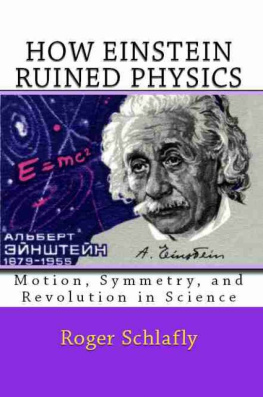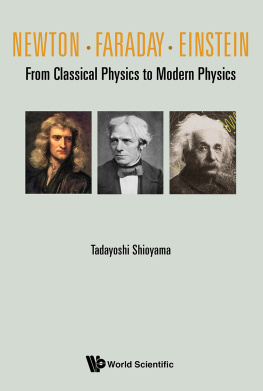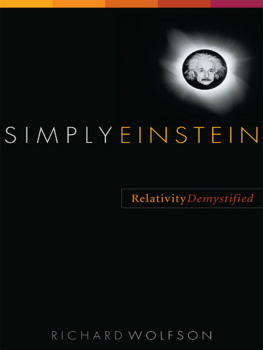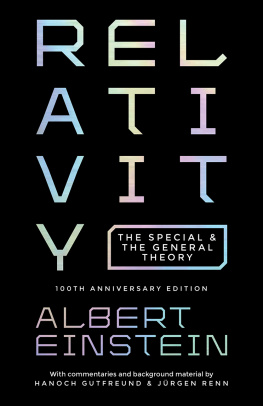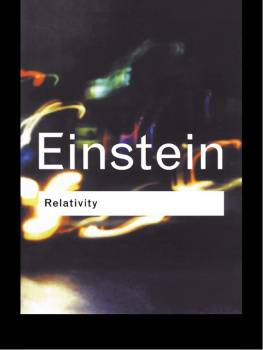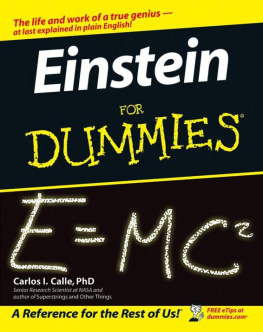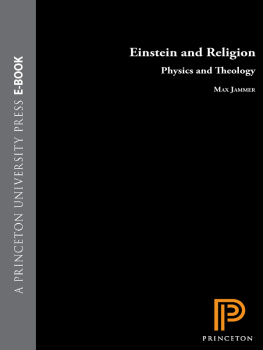How Einstein
Ruined Physics
Motion, Symmetry,and
Revolution inScience
Roger Schlafly
How Einstein Ruined Physics:
Motion, Symmetry, and Revolution inScience
By Roger Schlafly at Smashwords
Copyright 2011 Roger Schlafly
All rights reserved.
Smashwords Edition, License Notes
This ebook is licensed for your personalenjoyment only. This ebook may not be re-sold or given awayto other people. If you would like to share this book withanother person, please purchase an additional copy for eachrecipient. If youre reading this book and did not purchaseit, or it was not purchased for your use only, then please returnto Smashwords.com and purchase your own copy. Thank you forrespecting the hard work of this author.
Front cover art is from a 1979 USSR (CCCP)postage stamp.
It celebrates Albert Einstein, a centuryafter his birth.
Back cover:
Einstein was the greatest public idol of thetwentieth century. He became famous among the general public forbeing a great and humble genius, among intellectuals fordiscovering relativity, among philosophers for redefining thescientific revolution, and among physicists for his pursuit of aunified field theory. These are all great mistakes, and they havedriven physics research into the study of alternative universes andother ideas that have no scientific foundation.
This book carefully dissects these myths. Itexplains the development of relativity in the context of an ancientstruggle to understand motion and symmetry. It shows thatEinsteins role has been exaggerated, and has been used toundermine science. Physics is no longer the science that all othersciences emulate.
Edition 1.00c.
Additional information is atwww.DarkBuzz.com.
ISBN-13: 978-1461120193
ISBN-10: 1461120195
Contents
Albert Einstein was my hero. A century ago,he used mathematics to synthesize a new view of space and time, andnew principles of physics that have guided physics ever since. Hecame out of nowhere to invent relativity in a burst of abstractcreativity that no one has ever seen before or since. He was thegreat genius who defined the modern age, including everything fromlasers to atom bombs.
It is all a myth. Einstein did not inventrelativity or most of the other things for which he is credited. Heis mainly famous for popularizing the discoveries of others. Wehave all been duped.
The mathematics of relativity may be found incollege textbooks, and it is not detailed here. But at the core ofrelativity are some basic ideas about motion and symmetry that canbe traced back many centuries. One of those is the motion of theEarth. The ancient Greeks had good arguments for and against theidea that the Earth moves around the Sun. These issues were notresolved by Copernicus or Galileo. Until the invention ofrelativity, there were still experiments that seemed to imply thatthe Earth was motionless.
The Einstein myth is part of a larger set ofmyths about the nature of science, and about how new ideas replaceold ideas. The first is the flat Earth myth. Millions of peoplehave been taught that ancient and medieval scholars were too stupidto figure out that the Earth was round, and that the truth wassuppressed by religious and other narrow-minded authorities untilChristopher Columbus proved them wrong. In fact the ancient Greeksdeduced that the Earth was round and there has been no seriousdispute about it ever since.
The next myth concerns detecting the motionof the Earth. It is the most fundamental question in all ofphysics. Does the Earth move? How can such motion be demonstrated?Again, millions of people have been taught false and nonsensicalstories about how ancient astronomers were unscientific or aboutattempts to suppress the truth. According to the theory ofrelativity, motion is relative, and uniform motion is undetectableexcept in comparison to something else.
The philosophical myth is that scienceadvances by paradigm shifts, with the best examples being theCopernican revolution and Einsteins relativity. But the wholeconcept is a gross distortion of history, and a baseless attack onthe value of science.
The Einstein story has been told many times,and always incorrectly. The story is used to define what scienceis, how scientific ideas come to be accepted, and where science isgoing. And these lessons are entirely fallacious. Today professorscommonly teach that scientific progress is all an illusion, andthat acceptance of scientific theories has more to do with fashionthan objective truth. If we cannot be sure that Copernicus wascorrect about the motion of the Earth, they reason, then we cannotbe sure about anything. We can only arrive at truth by followingEinsteins example; searching for a unified theory of everything,ignoring experiments, and using philosophical arguments to convinceeveryone of the new paradigm. The argument is as silly as itsounds.
The discovery of relativity was indeed one ofthe greatest breakthroughs in the history of science, but thelessons being drawn from the Einstein myth are false, destructive,and contrary to the scientific method. Einstein is credited withrelativity for reasons that have nothing to do with any objectivereality, and his idolizers use his story to promote unscientifictheorizing.
Today's views of science are sharply dividedinto two factions. The pedestrians believe in scientific progress,and that it is accomplished by the sort ofobservation-hypothesis-experiment methodology that is practiced inschool science projects. The other view is that of the eliteintellectuals who insist on heaping the greatest praise on workwith no measurable or rational advantages.
This book explains the history of relativity,and how little Einstein had to do with it. It focuses on thefundamental concepts of motion and symmetry, and how these conceptshave puzzled brilliant scientists for centuries. The first realscience was astronomy, and the study of motion and symmetry in thesky guided all subsequent developments in physics.
If you drop a ball while you are running,will it land at your feet or behind you? You might think that theball would land behind you, but it will land at your feet.Likewise, if you drop a ball inside a car, it will land at thepoint directly below the drop, whether the car is stationary ormoving with uniform velocity. Also, the whole Earth could be movingat 1000 miles per hour, but you cannot notice it by dropping aball.
Instead of dropping balls, you can do afancier experiment with laser beams, and you still will not detectthe Earths motion. Relativity was discovered when physicists triedto reconcile such experiments with their knowledge about how lightbehaves like a wave in the aether. They were led to the conclusionthat either the Earth was stationary, or we needed a new concept ofspace and time. The theory of relativity is the idea that there aresymmetries of space and time that allow light to be a wave andmotion to be relative.
Relativity led to aprofound new understanding of motion and symmetry, and thatinspired a lot of 20 th century physics. It was real progress from realscience. Somehow philosophers have concluded that science jumpsirrationally without necessarily progressing towards truth, andphysicists have been persuaded to pursue Einsteins dream of aunified theory of physics that is unguided by any observationalevidence. This book explains how the Einstein myth has led to aseriously mistaken view of what science is all about.
About theauthor
Roger Schlafly got his BSE degree fromPrinceton University in Electrical Engineering (Engineering Physicsprogram), and his Ph.D. in Mathematics from the University ofCalifornia at Berkeley. He has taught at the University of Chicagoand the University of California at Santa Cruz. He currently livesin Santa Cruz, California.

